UK Consumer: Stronger fundamentals underpin prospects for consumer spending in 2015
The UK economy continues to tread a path of sustainable growth with preliminary estimates suggesting output was up 0.5% in the fourth quarter of 2014 compared with the previous quarter. This rounds off an impressive year with economic growth of 2.6% in 2014 - the fastest growth of any G7 economy.Chart 1: Economic growth driven by services sector
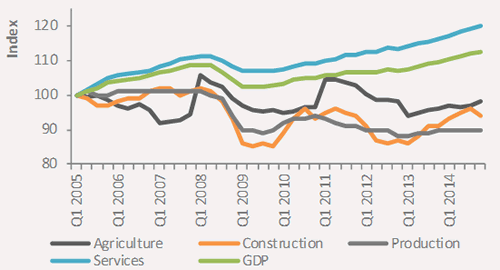
Source: ONSHowever, the recovery remains unbalanced with services continuing to be the main driver to date, with output standing 8.0% above its pre-crisis peak in Q1 2008. Construction (-7.8%) and Manufacturing (-10.9%) remain well below their pre-crisis peaks.
UK Consumer SpendingConsumer spending, which accounts for two thirds of the economy, has powered ahead growing 14 consecutive quarters to Q3 2014. Robust growth has developed despite the considerable pressure households have endured over the last five years through a combination of falling real incomes, high levels of unemployment and faltering confidence. After the initial shock of the recession, many households lowered levels of savings and dipped into existing savings to maintain spending habits. Products and services deemed luxuries in the past appear to be necessities today.The latest data for consumer confidence showed a notable rise in January 2015 for consumers’ appetite to make major purchases and expectations of personal finances over the next 12 months. This bodes well for spending in the first quarter of 2015. The trajectory of consumer confidence can act as a useful forward looking indicator for the path of consumer spending (chart 2). Chart 2: Consumer confidence is a lead indicator to spending
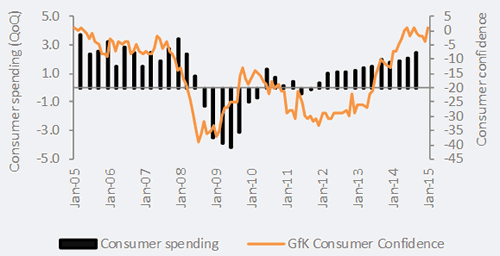
Source: ONS, GfK, Retail Economics analysisNew car registrations hit a 10-year high in December 2014 – a fundamental indicator for high levels of confidence. Chart 3: New car registrations hit nine year high
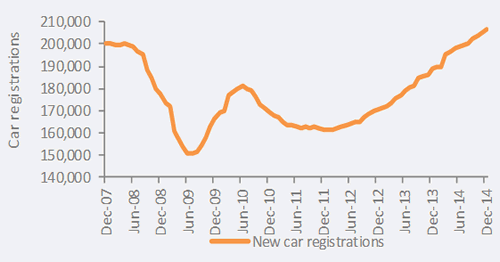
Source: SMMTWe believe that the outlook for consumer spending is underpinned by stronger fundamentals. Strong employment growth, low inflation, rising real incomes and improving credit conditions will boost consumer confidence which in-turn support spending.Oil prices have dropped significantly since last summer which will continue to put downward pressure on inflation, provide a boost to households’ discretionary spending power. Furthermore, the jobs market continues to strengthen and wage growth is likely to accelerate further. The latest data showed wage growth up 2.0%, easily outpacing inflation (+0.5%) for the third consecutive month. Our forecasts suggest overall consumer spending be up by around 3.0-3.5% in 2015.However, the global backdrop has become choppier in recent months with emerging market economies having deteriorated, the euro area remaining weak and the geopolitical tensions in Russia, Ukraine and the Middle East compounding uncertainty. Closer to home, the General election in May and the prospect of earlier than anticipated interest rate rises also make forecasts trickier.
Retail SalesRetail sales account for about a third of consumer spending and act as a useful bellwether for the economy. Retail sales in the final quarter grew at the fastest rate in 12 years with sales volumes up 2.3% compared with the previous quarter (chart 4). Chart 4: Retail sales (3m v previous 3m)
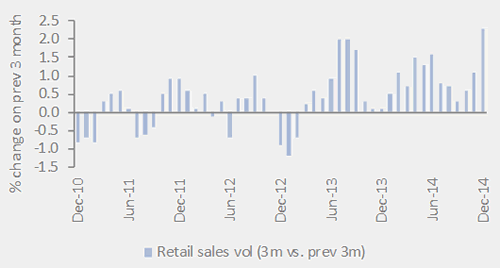
Source: ONSHowever, analysing December’s figures in isolation paints a slightly misleading picture due to the distorting impact “Black Friday” had on the timing of spending. Both the ONS and BRC surveys suggest that some Christmas spending, which traditionally would have occurred in December, had been brought forward to take advantage of Black Friday in November.Comparing the performance of sales growth between November and December in 2014 versus 2013 confirms the shift in spending. Chart 5 shows the significant drop off in sales in 2014 as spending was bought forward compared with 2013 when there was strong sales growth from November to December.However, it appears that not only did people bring forward spending but they actually spent more during the three months to December. Chart 5: Retail sales growth December vs November (2014 and 2013)
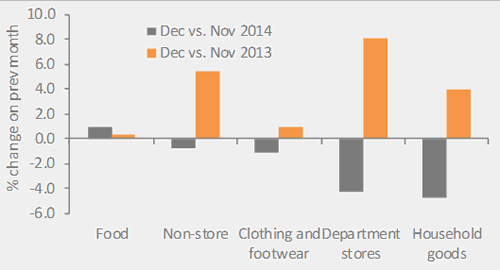
Source: ONSAs a result, ONS retail sales in December were up by 2.5% (value, non-seasonally adjusted), considerably weaker than November (+5.4%), but robust given the forward shift in spending. Many analysts were expecting much weaker growth, especially as the comparison was against a period last year which included Black Friday, according to the ONS calendar. This differed from the BRC which reported its weakest level of growth for December since 2008. But, December’s total sales of +1.0% does not point towards a collapse in sales, but rather a distortion that will need to be accounted for in Christmas sales periods to come. In fact, if you take October, November and December together, annual sales growth was c.1.5% up on the same three month period of the previous year which makes trading stronger, especially if you considering the drag that food sales and deflation have had over this period.This approach gives a much more rounded indication of performance for the Christmas period. So all in all, non-food sales are likely to have performed better than at first glance, however, any deep discounting from Black Friday would have eroded margins. It is also important to consider the impact of retail price deflation over this period which has dampened top line growth for values. The ONS retail sales deflator, an indication of retail inflation, fell by an annual 2.2% - the largest fall in prices since June 2002.
Back to Retail Economic News